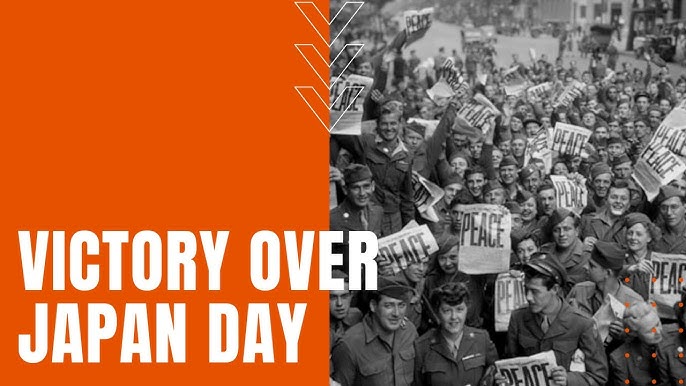Victory Over Japan Day, often abbreviated as V-J Day, marks the day Imperial Japan surrendered in World War II, effectively bringing the war to an end.
This momentous event is recognized around the world as a key historical turning point, not only for ending hostilities in the Pacific but also for symbolizing peace after years of global conflict. The surrender followed the devastating atomic bombings of Hiroshima and Nagasaki and the Soviet Union’s declaration of war against Japan.
When is Victory Over Japan Day Celebrated?
- Internationally recognized date: August 15, 1945 – the day Japan announced its surrender.
- United States official commemoration: September 2, 1945 – the day the formal surrender documents were signed aboard the USS Missouri in Tokyo Bay.
- In practice, some countries commemorate August 15, others September 2, and a few mark both.
Historical Background
In the closing months of World War II, the Allied forces issued the Potsdam Declaration (July 26, 1945), calling for Japan’s unconditional surrender. Japan initially refused. After the atomic bombings of Hiroshima (August 6) and Nagasaki (August 9), and the Soviet entry into the war, Emperor Hirohito intervened, urging the government to accept the Allied terms.
Global Significance
V-J Day is significant for several reasons:
- End of World War II: It brought closure to the most destructive war in human history.
- Start of a new geopolitical era: The war’s end led to the beginning of the Cold War and the reorganization of international politics.
- Peace and reconstruction: Nations began rebuilding, and Japan transitioned into a pacifist, democratic society.
- Human cost reflection: It’s a day to remember the soldiers, civilians, and victims of war, particularly those affected by the bombings and occupation.
How To Celebrate Victory Over Japan Day
Commemorations vary by country, but common ways to observe include:
1. Attending Ceremonies and Parades
- Many cities host veterans’ parades, wreath-laying ceremonies, and moments of silence at war memorials.
- Naval and military bases may hold formal remembrance events.
2. Educational Activities
- Schools and historical societies may host lectures, exhibitions, or film screenings about WWII in the Pacific.
- Museums often display artifacts, photographs, and oral histories from veterans.
3. Personal Reflection and Family Stories
- Families can discuss the impact of WWII on previous generations.
- Viewing historical footage of the Times Square celebrations in 1945 can provide a glimpse of the global relief and joy.
4. Visiting Historical Sites
- In the U.S., the USS Missouri Memorial in Pearl Harbor, Hawaii, is a key location.
- In Japan, Hiroshima and Nagasaki’s peace memorials focus on remembrance and reconciliation.
5. Acts of Peace and Friendship
- Some choose to mark the day by engaging in cultural exchanges or peace-promoting activities between Japan and other nations.
FAQs About Victory Over Japan Day
Q1: Is V-J Day the same as V-E Day?
No. V-E Day (Victory in Europe Day) marks Germany’s surrender on May 8, 1945, ending the war in Europe.
Q2: Why are there two different dates for V-J Day?
August 15 is when Japan announced its surrender; September 2 is when the formal documents were signed. Different countries emphasize one or the other.
Q3: Did Japan surrender because of the atomic bombs?
Historians debate this. The atomic bombings of Hiroshima and Nagasaki were critical factors, but so was the Soviet Union’s sudden entry into the war against Japan.
Q4: Do Japan and the U.S. celebrate V-J Day the same way?
No. Japan does not celebrate it as a victory but rather observes August 15 as a day of mourning and reflection for all those who died in the war.
Q5: Is V-J Day a public holiday?
In the U.S., it is not a federal holiday, though some states and localities observe it. In the U.K., Australia, and other Commonwealth nations, events are often organized, but it’s not a formal public holiday.
Q6: Why was the USS Missouri important?
The USS Missouri was the site where the surrender documents were signed, making it a symbol of the war’s official end.
Modern Perspectives on V-J Day
While originally marked with jubilant celebrations—famously captured in Alfred Eisenstaedt’s “The Kiss” photograph in Times Square—modern observances tend to be more solemn. They focus on honoring veterans, reflecting on the cost of war, and promoting peace.
In Japan, August 15 is a day of remembrance, with leaders visiting war memorials such as the Chidorigafuchi National Cemetery and making statements about peace. In the United States and other Allied nations, it’s an opportunity to both celebrate victory and acknowledge the sacrifices made on all sides.
Why It Still Matters Today
- Lessons from history: V-J Day reminds us of the dangers of global conflict and the value of diplomacy.
- Veteran recognition: With WWII veterans aging, these commemorations are a chance to express gratitude while they are still with us.
- Peace advocacy: It’s a chance to reaffirm commitments to peaceful resolutions in international disputes.
Summary
Victory Over Japan Day is more than just a historic milestone; it’s a reminder of resilience, sacrifice, and the enduring hope for peace. Whether marked with parades, quiet reflection, or educational events, it remains a day that resonates deeply across generations and borders.


Leave a Reply
You must be logged in to post a comment.